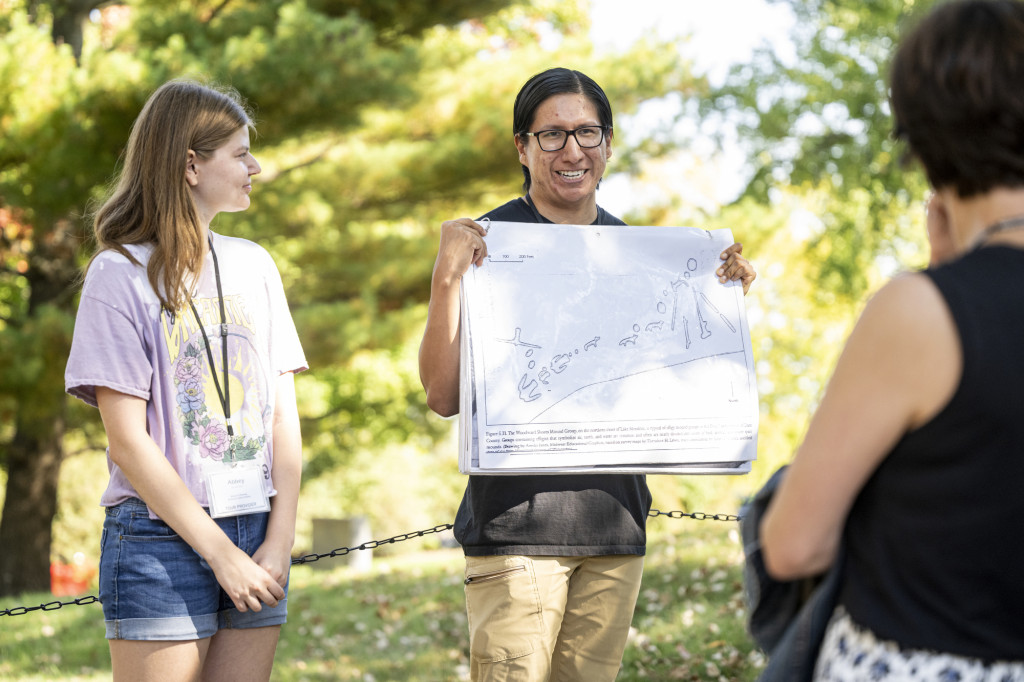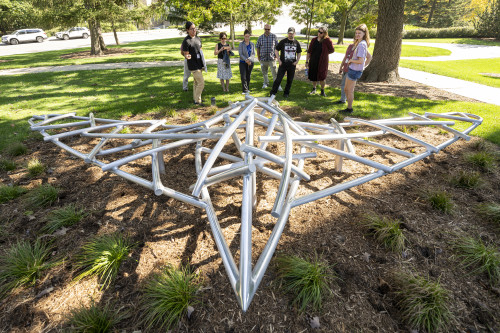Expansion of First Nations Cultural Landscape Tour will increase capacity of popular educational offering

Tour guide Kane Funmaker (right) holds a graphic showing the location of a variety of Ho-Chunk burial mounds on the north shore of Lake Mendota during a recent First Nations Cultural Landscape Tour. With him is fellow tour guide Abbey Woldt. Both are UW–Madison students and members of the Ho-Chunk Nation. The tour has added student guides so that the popular educational offering can be available to more groups. Photo: Bryce Richter
A popular campus tour at the University of Wisconsin–Madison that highlights the land’s historic and contemporary ties to Indigenous peoples has added tour guides and formalized its structure. The steps are expected to make the First Nations Cultural Landscape Tour available to more groups.
The tour examines the 12,000-plus years of human existence documented along the shores of Lake Mendota, particularly the history of the Ho-Chunk Nation, on whose ancestral land the university now sits.
The number of tour guides has grown from two to nine. And for the first time, some of the guides are UW–Madison students, several of whom are Ho-Chunk.

Pictured on Observatory Hill are tour guides and leaders of the First Nations Cultural Landscape Tour (from left): Annie Jones, a professor with UW–Madison’s Division of Extension; PhD nursing student and tour project assistant Brenda Owen; recent alumna and tour project assistant Sarah Lundquist; undergraduate Kane Funmaker; undergraduate Abbey Woldt; undergraduate Silas Cleveland; graduate student Rebecca Sikes; Sarah Splinter, assistant director of student engagement for Campus and Visitor Relations; and Omar Poler, Indigenous education coordinator with the Office of the Provost. (Not pictured: Professor Doug Reinemann, associate dean for outreach and extension in the College of Agricultural and Life Sciences). Photo: Bryce Richter
“The First Nations Cultural Landscape Tour is a deeply important learning opportunity for our campus community. More and more people want to experience the tour, and for good reason,” says John Zumbrunnen, senior vice provost for academic affairs and vice provost for teaching and learning. “The tour combines expert scholarship with place-based learning in engaging and novel ways.”
Over time, requests for the tours have exceeded availability.
“So many people on campus and in the community are committed to honoring the Indigenous cultures that have long called this special place home. One way to do that is by learning about the land and its history,” Zumbrunnen says. “We’re pleased to be able to provide additional institutional support for these tours so that more people can benefit from them.”
The tours began informally in 2003 as a way to support Indigenous students on campus and to increase their sense of belonging. Over the years, demand snowballed, largely through word of mouth. Until recently, almost all the tours were led by two university staff members — Aaron Bird Bear and Omar Poler — who took on the role in addition to their official university duties. Bird Bear, one of the tour’s co-founders, retired earlier this year.
Going forward, the tour will be offered through a partnership between the Office of the Provost and Campus and Visitor Relations (CAVR). CAVR is bringing its knowledge of tour operations and student tour guide training and professional development to the partnership. Funding for the tour expansion, including compensation for the student tour guides, is possible through grants provided by the Evjue Foundation and the Wisconsin Foundation & Alumni Association.

Tour guides Kane Funmaker (left) and Abbey Woldt (right) lead the First Nations Cultural Landscape Tour on the north side of Van Hise Hall. The tour stops by a sculpture titled “Effigy: Bird Form,” created by alumnus and Professor Emeritus Truman Lowe in 1997. It was recently installed on campus. Photo: Bryce Richter
“We’re excited to support the growth of the First Nations Cultural Landscape Tour and contribute our scheduling, training, and tour management knowledge to this important campus experience,” says Sarah Splinter, assistant director of student engagement for CAVR. “When we began discussing a partnership, we realized how much our interests aligned, and we were very eager to support the university’s efforts related to Indigenous education.”
Since 2016, a Native Nations working group at UW–Madison has sought to create educational networks, respectful research relationships and culturally responsive engagement programs with the 12 First Nations of Wisconsin. In 2019, the university installed the Our Shared Future heritage marker on Bascom Hill, pledging a shared future of collaboration and innovation with the Ho-Chunk Nation.
With the new tour structure, four highly trained UW–Madison students — undergraduates Kane Funmaker, Abbey Woldt and Silas Cleveland and graduate student Rebecca Sikes — have joined Poler to create a core team of guides. Four others will lead tours as their schedules allow: PhD nursing student Brenda Owen; Professor Doug Reinemann, associate dean for outreach and extension in the College of Agricultural and Life Sciences; Annie Jones, a professor with UW–Madison’s Division of Extension; and recent alumna Sarah Lundquist. Both Lundquist and Owen serve as tour project assistants.
“The tour is a counter-narrative of sorts,” says Owen, who is Ho-Chunk. “There is a rich history of 12,000-plus years of human presence with this land. UW–Madison has been here less than 2% of that time. I’m glad our university is expanding the narrative to be more inclusive. I think that shows its leadership nationally.”
This past summer, the tour leaders consulted with members of the Ho-Chunk Traditional Court, an esteemed group of clan elders. During an August visit to campus, the elders provided valuable feedback, offered encouragement, and engaged with the student tour guides.
Cleveland, a junior history major, says being a tour guide is helping him explore and process his own feelings about the treatment of Indigenous peoples in Wisconsin and at the university. He is Ho-Chunk and often weaves personal stories into the tours he leads.
“It means the world to me to be part of these tours — I almost don’t have the words to describe it,” he says. “This is a sacred place to me. I want people — especially my fellow students — to understand that there is so much more to the history and culture of Wisconsin than beer and cheese.”
The guides bring a mix of backgrounds, interests and personal histories, which will enrich the experience for tour participants, says Poler, the Indigenous education coordinator with the Office of the Provost and a member of the Mole Lake Band of Lake Superior Chippewa. Although the stops on each tour are generally the same, tour guides can customize their scripts to highlight what is most important to them or what may be most significant to a particular tour group, Poler says. This opens the possibility of people taking the tour more than once.
“Each tour guide is going to bring something different to the role and share it in a different way,” Poler says. “Someone could go on this tour any number of times and see history and the land through a different lens each time.”
The new guides met for a weeklong training in May and continue to meet regularly as a group for educational opportunities and to learn from each other.
“We see this as another valuable aspect of this new structure,” Poler says. “We are hopefully creating a supportive, sustainable learning community that will grow and change over time and that will not only ensure the long-term viability of these tours but also preserve meaningful personal experiences with the very special place where we live, work and study.”
For more information and to schedule a tour, please see the Campus and Visitor Relations website.
Tags: Ho-Chunk, indigenous, Native Nations




